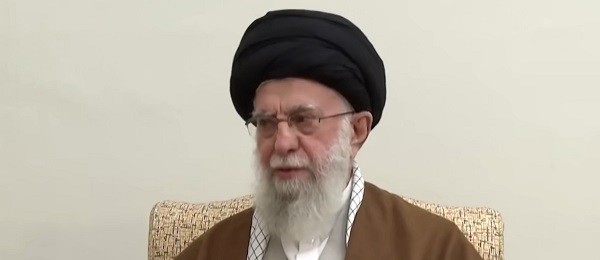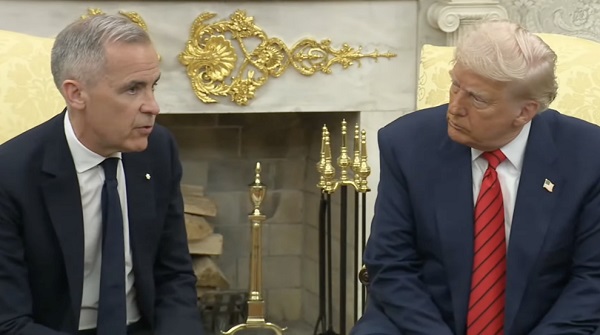conflict
White House Reportedly Worried About Russia’s Sudden Momentum Months After Biden Declared Putin ‘Already Lost’ War

 From the Daily Caller News Foundation
From the Daily Caller News Foundation
By NICK POPE
Manpower is a factor of growing significance for the Ukrainians, according to numerous reports. The war has claimed the lives of tens of thousands of Ukrainian soldiers, according to The Associated Press
White House officials are reportedly concerned that Russia may soon change the course of the conflict in Ukraine, less than a year after President Joe Biden said Russian President Vladimir Putin “already lost” the war, The New York Times reported Wednedsay.
Some aides and officials inside the Biden administration are concerned that Russia may be turning the war’s tide despite the U.S. government’s April approval of $61 billion of fresh aid for Ukraine, according to the NYT. The current level of concern stands in contrast to Biden’s comments in July 2023 that Putin had “already lost the war” and that there is “no possibility” the Russians prevail in the conflict.
“Putin’s already lost the war,” Biden said during a July 2023 press conference alongside then-Finnish President Sauli Niinisto. “Putin has a real problem. How does he move from here? What does he do? And so, the idea that there’s going to be, what vehicle is used, he could end the war tomorrow, he could just say ‘I’m out.’ But what agreement is ultimately reached depends upon Putin and what he decides to do, but there is no possibility of him winning the war in Ukraine.”
Sec Blinken announces another $2 Billion in aid to Ukraine pic.twitter.com/PLZ5Ylrjko
— Daily Caller (@DailyCaller) May 15, 2024
Eighteen months ago, Biden administration personnel debated among themselves whether or not Ukraine could fully expel the Russians from their territory, according to the Times. Now, a number of officials and aides are reportedly viewing the next few months as critical toward determining the conclusion of the conflict, whether that takes the shape of a negotiated cease-fire deal or some other resolution.
Russian forces captured a considerable amount of territory near Kharkiv in Ukraine’s northeast over the weekend, and the Ukrainian command has been forced to divert some of their own forces to the region, leaving other parts of the front less well-manned. Recent gains in the Kharkiv region represented the most mileage that the Russians have captured in a short period of time over the course of the whole war, excluding its earliest stages.
Notably, manpower is a factor of growing significance for the Ukrainians, according to numerous reports. The war has claimed the lives of tens of thousands of Ukrainian soldiers, according to The Associated Press, and the Ukrainian government has lowered the minimum age of conscription from 27 to 25 and started to send certain types of convicts to the front lines.
Ukrainian forces have also reportedly struggled to quickly train enough pilots to operate costly and sophisticated F-16 fighter jets provided by the U.S. Another issue on the front lines is that Russian forces have learned to use electronic techniques to counter drone and artillery systems provided to Ukraine by the West, according to the Times.
The Department of Defense (DOD) also believes that congress’ delays in authorizing the $61 billion package has contributed to the current situation on the front lines, a DOD spokesperson told the Daily Caller News Foundation. However, there is hope that the situation will improve as weapons covered by the aid package approved in April begin to arrive at the front lines en masse, with U.S. officials currently expecting that the weapons will begin to make a real difference in July, according to the Times.
“On Friday, we warned that we had been anticipating that Russia would launch an offensive against Kharkiv and were anticipating that Russia would increase its attacks in an attempt to establish a shallow buffer zone along the Ukrainian border – and we have been coordinating closely with Ukraine to help them prepare,” the DOD spokesperson told the DCNF. “As we have said previously, Congress’ months-long delay in passing the supplemental put the Russians at an advantage, and it will take Ukraine time to regain the initiative. It is possible that Russia will make further advances in the coming weeks, but over time, the influx of U.S. assistance will enable Ukraine to withstand these attacks over the course of 2024.”
The DOD is “moving heaven and earth” to get weapons to the Ukrainians as soon as possible, and the agency is also preparing a new aid package to assist Ukrainian forces, the spokesperson added. Since the war started in February 2022, the U.S. alone has spent more than $100 billion to support the Ukrainian war effort, according to the Council on Foreign Relations.
The White House did not respond immediately to a request for comment.
conflict
Obama Dropped Over 26K Bombs Without Congressional Approval

@miss_stacey_ Biden, Clinton, Obama & Harris on Iran #biden #clinton #obama #harris #trump #iran #nuclear
Iran has been the target for decades. Biden, Harris, and Clinton—all the Democrats have said that they would attack Iran if given the opportunity. It appears that Donald Trump is attempting to mitigate a potentially irresolvable situation. As he bluntly told reporters: We basically — we have two countries that have been fighting so long and so hard that they don’t know what the f‑‑‑ they’re doing.”
A portion of the nation believes Trump acted like a dictator by attacking Iran without Congressional approval. I explained how former President Barack Obama decimated the War Powers Resolution Act when he decided Libya was overdue for a regime change. The War Powers Act, or War Powers Resolution of 1973, grants the POTUS the ability to send American troops into battle if Congress receives a 48-hour notice. The stipulation here is that troops cannot remain in battle for over 60 days unless Congress authorizes a declaration of war. Congress could also remove US forces at any time by passing a resolution.
Libya is one of seven nations that Obama bombed without Congressional approval, yet no one remembers him as a wartime president, as the United States was not technically at war. Over 26,000 bombs were deployed across 7 nations under his command in 2016 alone. Libya, Afghanistan, Syria, Yemen, Somalia, Iraq, and Pakistan were attacked without a single vote. Donald Trump’s recent orders saw 36 bombs deployed in Iran.
The majority of those bombings happened in Syria, Libya, and Iraq under the premise of targeting extremist groups like ISIS. Drone strikes were carried out across Somalia, Yemen, and Pakistan as the Obama Administration accused those nations of hosting al-Qaeda affiliated groups. Coincidentally, USAID was also providing funding to those groups.
The 2001 Authorization for Use of Military Force (AUMF) was initially implemented to hunt down the Taliban and al-Qaeda after the 9/11 terrorist attacks. Obama broadened his interpretation of the AUMF and incorporated newly formed militant groups that were allegedly expanding across the entire Middle East. The Bureau of Investigative Journalism believes there were up to 1,100 civilian casualties in Pakistan, Yemen, and Somalia. Thousands of civilians died in Syria and Iraq but the death toll was never calculated. At least 100 innocent people died in the 2016 attacks in Afghanistan alone.
The government will always augment the law for their personal agenda. The War Powers Resolution was ignored and the AUMF was altered. Congress was, however, successful in preventing Obama from putting US troops on the ground and fighting a full-scale war. In 2013, Obama sought congressional approval for military action in Syria but was denied. Obama again attempted to deploy troops in 2015 but was denied. Congress has to redraft the AUMF to specifically prevent Obama from deploying troops in the Middle East. “The authorization… does not authorize the use of the United States Armed Forces on the ground in Syria for the purpose of combat operations.” Obama attempted to redraft the AUMF on his own by insisting he would prohibit “enduring offensive ground combat operations” or long-term deployment of troops. He was met with bipartisan disapproval as both sides believed he was attempting to drag the United States into another unnecessary war.
The United States should not be involved in any of these battles, but here we are. Those living in fear that Donald Trump is a dictator fail to recognize that past leadership had every intention of sending American men and women into battle unilaterally without a single vote cast.
conflict
The Oil Price Spike That Didn’t Happen


From the Daily Caller News Foundation
By David Blackmon
What if they gave an oil price spike and nobody came? That is admittedly kind of a lame play on an old saying about parties, but it’s exactly what has happened over the two weeks since June 12, when Israel launched its initial assault on Iran.
At that day’s close of trading, the domestic U.S. WTI price sat at $68.04 per barrel. As of this writing on June 24, the price stands at $64.50. That’s not just the absence of a price spike, it is the opposite of one, a drop of 5% in just two weeks.
So, what happened? Why didn’t crude prices spike significantly? For such a seemingly complex trading market that is impacted daily by a broad variety of factors, the answer here is surprisingly simple, boiling down to just two key factors.
Dear Readers:
As a nonprofit, we are dependent on the generosity of our readers.
Please consider making a small donation of any amount here.
Thank you!
- Neither Israel nor the United States made an effort to target Iran’s refining or export infrastructures.
- Despite some tepid, sporadic saber rattling by Iranian officials, they mounted no real effort to block the flow of crude tankers through the region’s critical choke point, the Strait of Hormuz.
Hitting Iran’s infrastructure could have taken its substantial crude exports – which the International Energy Agency estimates to be 1.7 million barrels per day – off the global market, a big hit. Shutting down the Strait of Hormuz, through which about 20% of global crude supplies flow every day, would have been a much bigger hit, one that would have set prices on an upward spiral.
But the oil kept flowing, muting the few comparatively small increases in prices which did come about.
Respected analyst David Ramsden-Wood, writing at his “HotTakeOfTheDay” Substack newsletter, summed it up quite well. “Oil is still structurally bearish. U.S. producers are in PR mode—talking up ‘Drill, baby, drill’ while actually slowing down. Capex is flat to declining. Rig counts are down. Shareholders want returns, not growth. So we’re left with this: Tension in the Middle East, no supply impact, and U.S. production that’s quietly rolling over. Oil shrugged.”
There was a time, as recently as 10 years ago, when crude prices would have no doubt rocketed skywards at the news of both the commencement of Israel’s initial June 12 assault on Iran’s military and political targets and of last Saturday’s U.S. bombing operation. In those days, we could have expected crude prices to go as high as $100 per barrel or even higher. Markets used to really react to the “tension in the Middle East” to which Ramsden-Wood refers, in large part, because they had no real way to parse through all the uncertainties such events might create.
Now it’s different. Things have changed. The rise of machine learning, AI and other technological and communications advancements has played a major role.
In the past, a lack of real-time information during any rise in Middle East tensions left traders in the dark for some period of time – often extended periods – about potential impacts on production in the world’s biggest oil producing region. But that is no longer the case. Traders can now gauge potential impacts almost immediately.
That was especially true throughout this most recent upset, due to President Donald Trump’s transparency about everything that was taking place. You were able to know exactly what the U.S. was planning to do or had done just by regularly pressing the “refresh” button at Trump’s Truth Social feed.
Tim Stewart, President of the D.C.-based U.S. Oil and Gas Association, has a term for this. “The Markets are becoming much better at building the ‘47 Variable’ into their short-term models,” he said in an email. “This is not a Republican Administration – it is a Disrupter Administration and disruption happens both ways, so the old playbooks just don’t apply anymore. Traders are taking into account a President who means what he says, and it is best to plan for it.”
Add to all that the reality that a high percentage of crude trading is now conducted via automated, AI-controlled programs, and few trades are any longer made in the dark.
Thus, the world saw a price spike which, despite being widely predicted by many smart people, didn’t happen, and the reasons why are pretty simple.
David Blackmon is an energy writer and consultant based in Texas. He spent 40 years in the oil and gas business, where he specialized in public policy and communications.
(Featured Image Media Credit: Screen Capture/PBS NewsHour)
-

 Alberta1 day ago
Alberta1 day agoAlberta judge sides with LGBT activists, allows ‘gender transitions’ for kids to continue
-

 Crime20 hours ago
Crime20 hours agoNational Health Care Fraud Takedown Results in 324 Defendants Charged in Connection with Over $14.6 Billion in Alleged Fraud
-

 Health20 hours ago
Health20 hours agoRFK Jr. Unloads Disturbing Vaccine Secrets on Tucker—And Surprises Everyone on Trump
-

 Business9 hours ago
Business9 hours agoElon Musk slams Trump’s ‘Big Beautiful Bill,’ calls for new political party
-

 Business2 days ago
Business2 days agoCanada Caves: Carney ditches digital services tax after criticism from Trump
-

 Alberta1 day ago
Alberta1 day agoAlberta Independence Seekers Take First Step: Citizen Initiative Application Approved, Notice of Initiative Petition Issued
-

 Censorship Industrial Complex8 hours ago
Censorship Industrial Complex8 hours agoGlobal media alliance colluded with foreign nations to crush free speech in America: House report
-

 Crime2 days ago
Crime2 days agoSuspected ambush leaves two firefighters dead in Idaho








